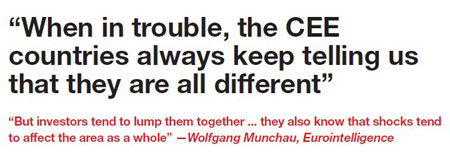EM REGIONAL BANKING FOCUS: CENTRAL & EASTERN EUROPE
By Jonathan Gregson
Hit hard during the financial crisis, Central and Eastern Europe’s banking sector is still fragile and vulnerable to external shocks.

During the boom times of the past decade, Central and Eastern Europe (CEE) was playing catch-up on the more mature Western economies. Annual GDP growth was near double the EU average, consumers were—often for the first time—buying cars and houses, while the mostly Western-owned banks were lending hand-over-fist to corporates and individuals alike, confident that their funding needs could be provided cheaply on the wholesale market.
Then came the credit freeze and recession. Countries with free-floating currencies, such as Russia, suffered sharp depreciations and capital flight. Eurozone candidates like the Baltic states had to impose harsh austerity measures.
Last year, average GDP for CEE countries fell 3.6%; for the formerly Soviet Commonwealth of Independent States (CIS), it was 6.6%. Russia’s dived by roughly 8%. Credit evaporated. And while few banks failed, many were bailed out, forcibly merged with stronger partners or restructured.
IMF standby facilities were called upon for the worst-hit countries, like Serbia and Ukraine. Western-owned banks were persuaded, with the backing of the European Bank for Reconstruction and Development (EBRD) and other multilaterals, to sign up to the ‘Vienna Initiative’ and maintain financial commitments to their CEE subsidiaries, who in turn could continue lending to corporate and individual customers.
So far, it seems to have worked. The IMF recently raised its average GDP forecast for CEE countries this year to growth of 3.2%, and that was before more-buoyant figures for their key market, the eurozone, came out last month. IMF forecasts for Russia leaped to 4.3% growth.
Daniel Cappelletti, the Prague-based partner of consultancy PwC responsible for strategy in CEE, sees this resilience as due to a combination of factors. He explains: “Governments stepped in with stimulus packages, households were not so leveraged as in the West, while among corporates there have been surprisingly few insolvencies because the banks have kept lending” although this may be because there is often no managed route to bankruptcy, so instead banks have demanded higher fees and extended repayment terms.
“Banks have been working hard to get their loan portfolios back into shape,” says Cappelletti, “so the danger of systemic contagion has been reduced.” Total banking assets were flat last year across “inner” Central Europe, though in southeastern Europe and the CIS they rose marginally as a percentage of GDP.

“Corporates are increasingly careful about their bank borrowings, and many are deleveraging,” Cappelletti adds. As a result of such caution, bank loans to Central European private companies were down 4% last year, according to Raiffeisen Research. However, Capelletti sees corporate bonds coming back into favor. Wolfgang Ernst, CEE macro analyst at Raiffeisen Research in Vienna, agrees: “The banks have very high liquidity,” he says. “The main constraints on lending are tighter risk management and weak demand. Credit demand is picking up in Russia and even in Ukraine, where the banking system nearly stopped working last year, which is a huge step toward normalization,” he adds.
M&A; activity is taking off again, with Spain’s Banco Santander buying into Poland’s Bank Zachodni WBK. In Russia, those banks bailed out by state-owned entities during the financial crisis are likely to be put up for sale. “We will probably see further consolidation, as there are some banks, like Allied Irish Bank, that have to sell assets and have decided to leave the region, while others, like Santander, are seeking to enter or expand their presence,” says Stefan Maxian, the Vienna-based senior manager for company research at Raiffeisen Centrobank. Raiffeisen itself is merging its Raiffeisen International arm and the principle businesses of its RZB arm in order to capitalize on the opportunities arising in the region. The new entity, RBI, will have access to both the debt and equity markets, says its CEO Herbert Stepic. “The merger thus provides RBI with improved access to funding and capital to capture the revitalized growth potential in CEE,” he adds.
The Basel III higher-capital-adequacy requirements announced last month are unlikely to have a significant impact on large listed banks in countries like Poland, the Czech Republic or Hungary, Maxian believes. However they might cause problems for some smaller banks, especially those with many local subsidiaries or minority shareholdings whose Tier 1 capital might not count toward the group’s overall scoring.
Alex Lehmann, a senior economist at the EBRD, says there is concern about minority stakes in otherwise foreign-owned banks being excluded from calculations of group capital adequacy under Basel III. In his opinion, that capital needs to be “freely fungible.”
Most CEE experts stress the differences between stronger economies such as Poland and those that lag behind, like most of the Balkan nation-states. Other, more investor-facing analysts take a different view. “When in trouble, the CEE countries always keep telling us that they are all different,” says Wolfgang Munchau, president of the eurozone macro-economic website Eurointelligence.com. “But investors tend to lump them together, and while they know that Poland is relatively sound, they also know that shocks tend to affect the area as a whole.”
Slow growth in the EU adversely affects all CEE countries, while Greece’s difficulties over its sovereign debt hit neighboring Balkan countries where Greek banks have built up a large presence. Another potential hazard is uncoordinated decisions to impose taxes on banks. Hungary, which has walked away from its IMF agreement, recently imposed a 0.5% tax on banks’ balance sheets. Given the generally tight lending environment, prohibitively high interest rates in the local currency and the restriction of foreign currency lending by extreme exchange rate volatility, adding a bank tax only exacerbates the downturn in lending, critics claim.
Corporates are keeping inventories low and remain wary of increasing bank loans, according to Maxian. He nonetheless sees “lending to corporates growing faster than retail lending, as many countries, such as Romania, have had to adopt severe austerity measures which will take time to digest before consumers start spending again.”
A large part of the region’s credit problems stem from companies and consumers’ having taken out foreign currency loans at lower rates of interest. “One could have defended a euro-linker,” says Munchau, “given the officially stated policy to join the eurozone eventually. But Swiss franc and yen linkers suggest lenders were “exploiting the gullibility of countries with no experience of financial markets, as a collapse in the exchange rate would bring imminent financial ruin to a lot of poor people.”
The political reaction to ballooning foreign currency mortgages has led to measures to curb such lending in some countries, though, as Ernst points out, credit quality is more affected by unemployment than currency levels. Unfortunately, there is a time lag before economic growth starts to generate new jobs, and in some CEE countries, such as Romania, social tensions are rising. Indeed, as the IMF recently warned, the breakdown of social cohesion could soon be the biggest drag on further economic recovery.



